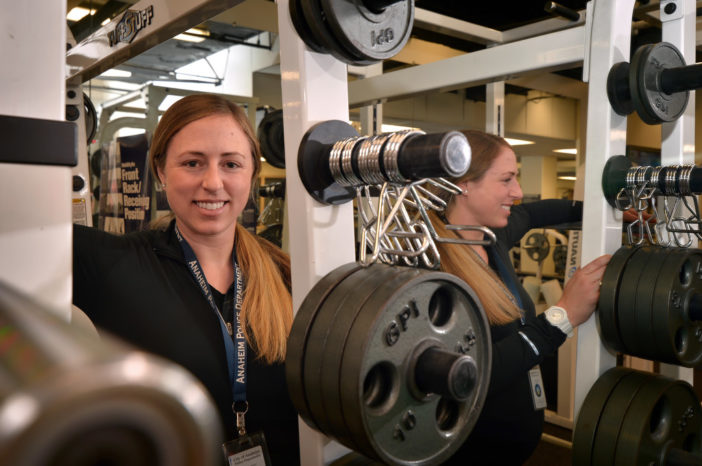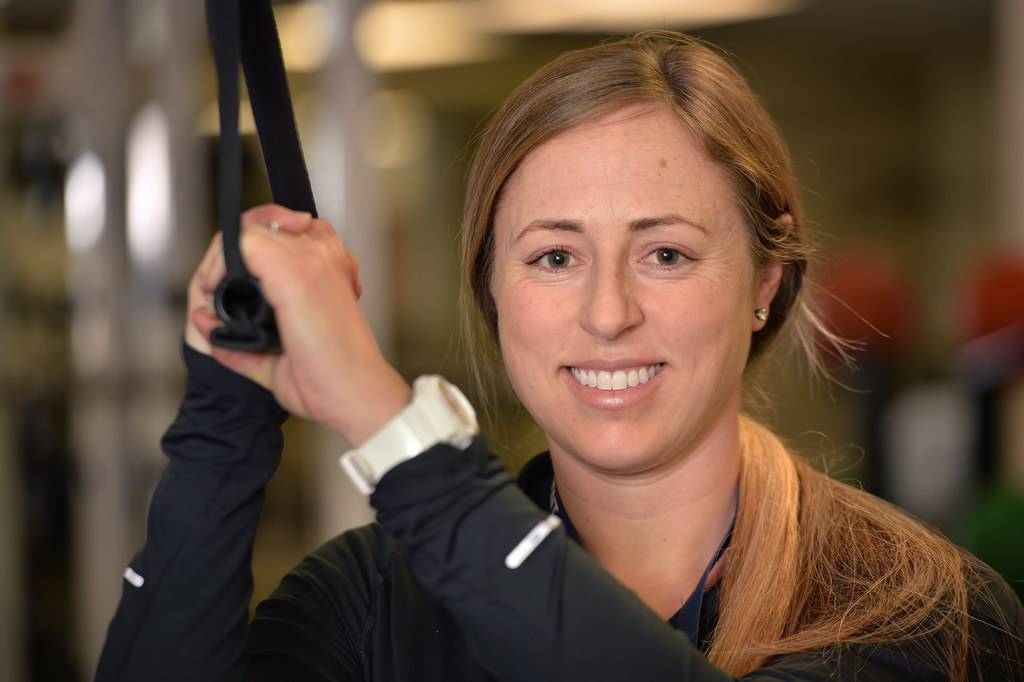June 28, 2013 was an important day in Lt. Rich LaRochelle’s life. At over 300 pounds, it was the day he decided to lose weight and regain control of his health.
Since then he’s lost 101 pounds, and he owes at least part of that success to the Anaheim Police Department’s wellness program.
“I was a big man,” said LaRochelle. “I should have never gotten to that point.”
The APD has had a wellness program, designed and implemented by Wellness Solutions, including a full-time director onsite at APD, since 2000.
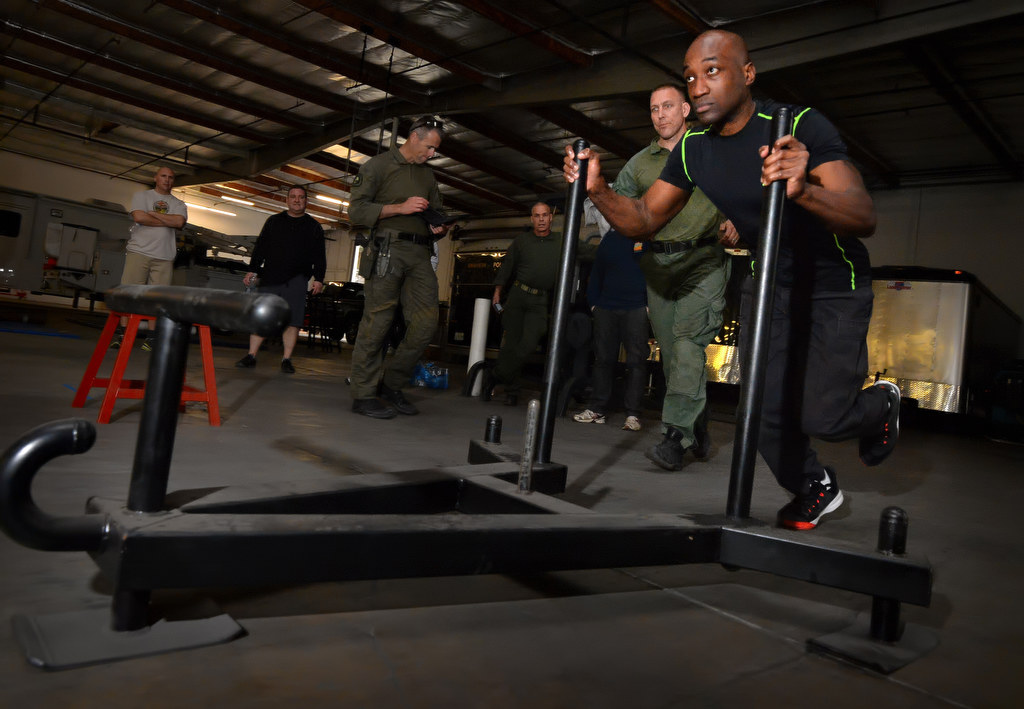
Anaheim PD Officer Sheddi Skeete pushes a weight across the workout room at the APD during a timed obstacle course.
Photo by Steven Georges/Behind the Badge OC
“They had recently lost two chiefs to heart attacks within about five years of each other,” says Wellness Director Kari Throop, an American College of Sports Medicine-certified exercise physiologist, who has served as director since 2006. “I think it was sort of a wake-up call.”
After 10 years of working to keep police officers and other support staff healthy, Throop is leaving her post with the APD and Wellness Solutions (the worksite health promotion company the department contracts with for the wellness program).
She’s going on maternity leave, but rather than disrupt the department with a temporary director, she decided it was time to close the chapter on her time at the APD and move on.

Kari Throop, senior wellness manager for the Anaheim PD and Wellness Solutions, in one of the workout rooms at police headquarters.
Photo by Steven Georges/Behind the Badge OC
She’s happy with what she’s been able to accomplish with the program.
“I think that Anaheim has a way more advanced comprehensive program than anywhere else in the U.S.,” Throop says.
She also knows the new coordinator, Marci Guzman, will have plenty of work ahead.
“Really the goal of a program like this is to change the culture (of the PD) over time,” Throop says.
IT’S TOUGH BEING A COP
Police officers deal with stress on a daily basis, potential injury from being out on patrol and a lot of sitting — all of which can combine into a perfect storm of potential health problems.

Anaheim PD Officer Sheddi Skeete climbs over a wall as part of a timed obstacle course.
Photo by Steven Georges/Behind the Badge OC
According to one study administered by Throop, 40 percent of those surveyed in patrol experienced pain. Other cops reported issues including stress, lack of sleep, lack of fitness, abuse of caffeine or alcohol, and depression.
The three most common injuries Throop sees are in the back, shoulders and knees.
“I think most people know about the lower back, just with the amount of time that they sit in a vehicle or they sit at a desk,” she says, adding that lack of fitness, poor nutrition and gear they must wear also play a role in back health. “It’s the same with the shoulder. … When they’re in an altercation, the shoulder can be injured.”
Knee injuries often are a result of repetitive motion of getting into and out of a patrol vehicle, day in and day out. Also, the physicality required of being a police officer doesn’t help.
“If they come over a wall and land wrong, (injuries can occur),” Throop says.
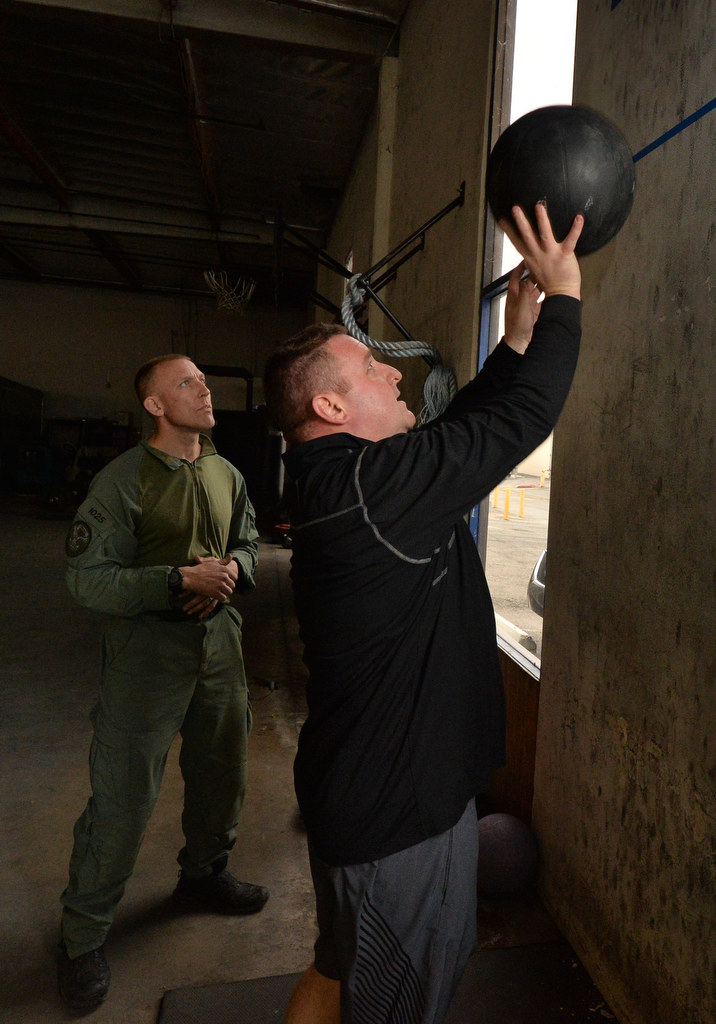
Anaheim PD Lt. Bob Dunn tosses a weighted ball above a line on a wall as part of a timed obstacle course as Officer Garrett Cross, left, follows him to each station.
Photo by Steven Georges/Behind the Badge OC
Then, of course, there’s high blood pressure, diabetes, high cholesterol, obesity, sleep disorders (all stress-related symptoms), etc.
A barrier to officers getting healthier is a penchant among cops for trying to maintain a strong appearance.
“They don’t want to appear weak in any way,” Throop says. “That (mentality) needs to change. They have to realize that these things are going to happen to them. And it’s better to deal with them before they become too chronic or too debilitating.”
Compounding this barrier to better health is that officers are having to work to an older age before retirement, which means agencies will be dealing with an aging population of cops – in other words, the need for a wellness program isn’t going away any time soon.
HOW THE PROGRAM CAN HELP
Since the beginning, the goals of the Wellness Incentive Program (WIN) have been to reduce the risk of cardiovascular disease through blood pressure, cholesterol and body composition reduction; encourage improvement of physical fitness levels for job performance; reduce the frequency, severity and cost of injury; and provide stress management techniques.
By subcontracting through Santa Ana College’s Fire Technology Wellness Program, which provides low-cost blood work and fitness assessments to the Anaheim PD, WIN offers employees comprehensive blood screening tests. Throop then goes over the results with the employee and can refer him or her to a doctor if necessary.
“Just in that alone, we’ve seen … diabetes, high cholesterol, we’ve seen even things like celiac disease or something that indicates an infection,” she says.

Anaheim PD Officer Trang Pham balances himself as he walks across a log near the end of a timed obstacle course.
Photo by Steven Georges/Behind the Badge OC
Another part of the program utilizing Santa Ana College is a comprehensive fitness assessment, including body fat, strength and flexibility, and an EKG treadmill test.
In addition to a consultation with Throop based on the results (including specific exercise routines), the college can compare the individual’s results to a police officer, firefighter or civilian in his or her gender and age group, and provide a ranking, an overall health score and a physiological age.
“It’s really great medical information for their records,” says Throop.
The EKG treadmill test is how Sgt. Bryan Janocha found out about his heart murmur a couple of years ago.
“I would never get my blood work done and have an EKG done on my own,” he says. “It is only because of the fitness program that I had that checked. When I was told of my heart murmur, I took the results to my doctor and now have a yearly physical and have the doctor check my EKG results each year.”

Treadmills are among several workout options in one of the workout rooms available to Anaheim PD employees inside police headquarters on Harbor Boulevard.
Photo by Steven Georges/Behind the Badge OC
Janocha also is a fan of the incentive part of WIN: Officers (anyone can participate but only officers can get incentives) can earn a $200 reimbursement for health-related items, including gym membership, and also can earn a healthy day off – 12 hours – every year.
To earn the incentive, officers must complete the components of the program (blood work, fitness assessment, activity log and seminar attendance). The amount of Paid Leave awarded is based on completion and outcome measures related to blood pressure, body composition, cholesterol, and overall health and fitness.
“Kari often is in her office – which is the weight room – and will talk fitness with me, answer fitness questions while I work out,” Janocha says. “She also will show me different exercises and different ways to target certain muscles.”
Throop puts on a body fat loss challenge every year in which teams of three to five employees can compete over 10-12 weeks to see who loses the most body fat.
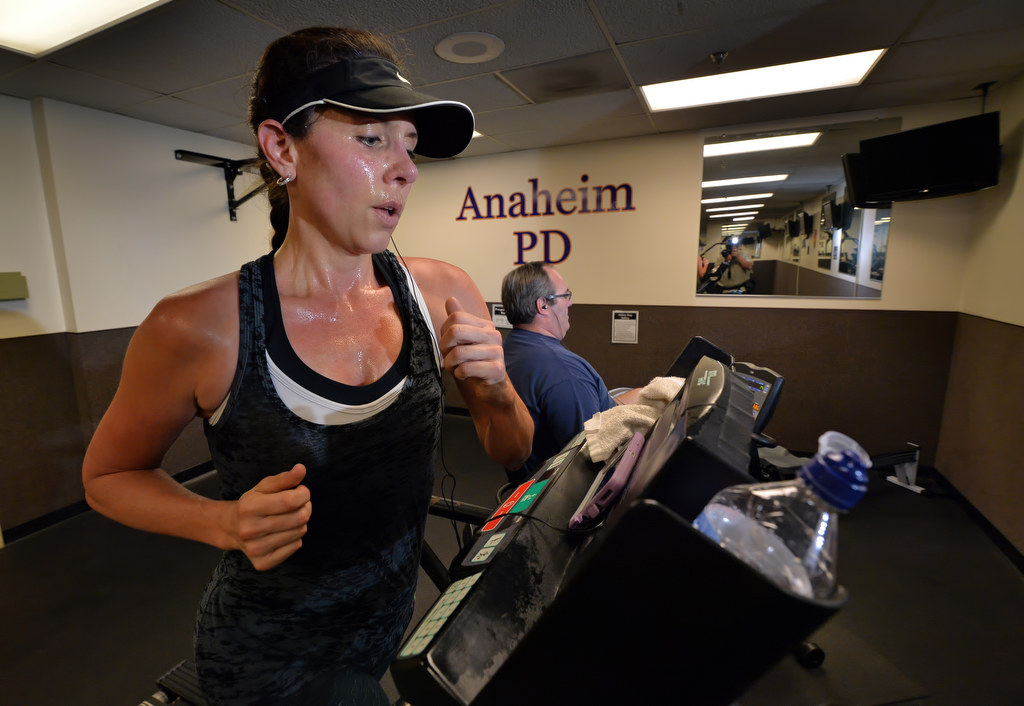
Anaheim PD Officer Robin Wallace works out on a treadmill at APD headquarters.
Photo by Steven Georges/Behind the Badge OC
“Cops are very competitive,” she says.
Other ways Throop has helped members of the APD get healthier include teaching classes on mindfulness, stress reduction and yoga; making sure equipment is ergonomically sound; and setting up Heart Math, a program that helps employees regulate stress through biofeedback.
“I’m here to offer whatever resources I can,” she says.
In addition to all of this, Throop is involved in decision- and policy-making related to the department’s health and wellness, and supports wellness studies to collect data on the state of injury and stress in the department.
THE NUMBERS
Based on participation rates, all the hard work is paying off.
“We’re definitely making changes,” Throop says.
In terms of participation, the department has had 670 different employees try WIN since its inception in 2000 (there are roughly 650 employees currently in the department).

(From left) Anaheim PD Officer Garrett Cross, Officer Erik Degn, Senior Wellness Manager Kari Throop and Officer Brian Leist.
Photo by Steven Georges/Behind the Badge OC
The program attracts 25 new people each year, and 55 percent of participants have gone through the program at least once every three years.
On average, there are 185 participants each year – about 40 percent of sworn employees, or 65 percent of those on patrol, in a given year.
The WIN program has resulted in a 30 percent lower incidence of sprains and strains, and 36 percent lower cost associated with sprains and strains. In this year’s report of individual data, 85-95 percent of high-risk employees moved into a normal range after being tested a year later.
“This is crucial for police departments because this job is so stressful and demanding on the body; we need a way to keep officers in shape and healthy,” Janocha says.
“When you call 911, you want someone to respond who can get the job done.”
 Behind the Badge
Behind the Badge
